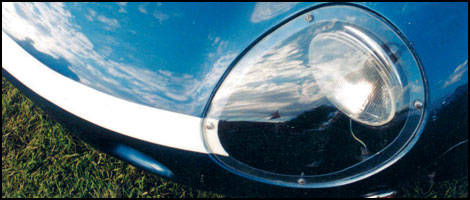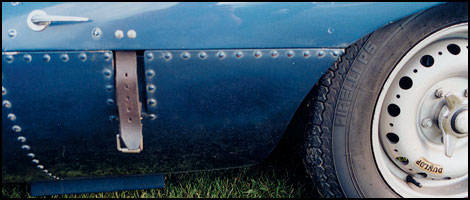Light, lithe and a treat for the eyes, the highly advanced D-Type was Jaguar's most successful racing car
The pristine D-Type Jaguar sits parked on the lush, green grounds of the Earl of March's estate. Its taught aluminum skin, painted a sober shade of blue with large white dots (where a number or two could be added), glisten in the afternoon sun. Not an everyday sight, but the annual Goodwood Festival of Speed, a three-day time warp featuring some of the finest and rarest racing machinery ever built, isn't your everyday event.
Goodwood is the kind of place where the public--who visit from all over the world--can get up close and personal with untold millions of dollars worth of race cars, from turn-of-the-century horseless carriages, to present-day Formula One screamers. You also get to watch them zoom up the mile-long driveway in front of the Earl's stately mansion as their famous-name drivers, both active and retired, vie for class honours in the elapsed-time department.
The D-Type is here because it represents the pinnacle of Jaguar's success on the track. No other pure-bred competition-built Jag before or since has achieved its success. One look at this five-decade-old design, with its gently rounded bodywork and signature tailfin, and you know you're in the presence of greatness.
The very existence of the D-Type was the result of William Lyons (later Sir William Lyons), Jaguar's founder. This former motorcycle side-car manufacturer put much emphasis on improving and showcasing his cars through various forms of competition. Lyons achieved his first taste of fame in the mid-to-late 1930s with his SS 100, a two-seat roadster that achieved success in hillclimbs and rallys throughout Britain and the European Continent.
Following the Second World War, Jaguar engineers developed the C-Type, a rebodied and specially prepared XK120 that fulfilled Lyons' desire to compete in the most prestigious road race of them all, the French 24 Hours of Le Mans. Here, it proved its worth by capturing victories in 1951 and 1953 and went on to successfully compete in road races throughout Europe and North America for many years after.
As good as the C-Type was, it became obvious that the competition, represented by Ferrari, Maserati, Porsche, Aston Martin and others, was beginning to threaten Jaguar's racing supremacy.
The pristine D-Type Jaguar sits parked on the lush, green grounds of the Earl of March's estate. Its taught aluminum skin, painted a sober shade of blue with large white dots (where a number or two could be added), glisten in the afternoon sun. Not an everyday sight, but the annual Goodwood Festival of Speed, a three-day time warp featuring some of the finest and rarest racing machinery ever built, isn't your everyday event.
 |
Goodwood is the kind of place where the public--who visit from all over the world--can get up close and personal with untold millions of dollars worth of race cars, from turn-of-the-century horseless carriages, to present-day Formula One screamers. You also get to watch them zoom up the mile-long driveway in front of the Earl's stately mansion as their famous-name drivers, both active and retired, vie for class honours in the elapsed-time department.
The D-Type is here because it represents the pinnacle of Jaguar's success on the track. No other pure-bred competition-built Jag before or since has achieved its success. One look at this five-decade-old design, with its gently rounded bodywork and signature tailfin, and you know you're in the presence of greatness.
The very existence of the D-Type was the result of William Lyons (later Sir William Lyons), Jaguar's founder. This former motorcycle side-car manufacturer put much emphasis on improving and showcasing his cars through various forms of competition. Lyons achieved his first taste of fame in the mid-to-late 1930s with his SS 100, a two-seat roadster that achieved success in hillclimbs and rallys throughout Britain and the European Continent.
Following the Second World War, Jaguar engineers developed the C-Type, a rebodied and specially prepared XK120 that fulfilled Lyons' desire to compete in the most prestigious road race of them all, the French 24 Hours of Le Mans. Here, it proved its worth by capturing victories in 1951 and 1953 and went on to successfully compete in road races throughout Europe and North America for many years after.
As good as the C-Type was, it became obvious that the competition, represented by Ferrari, Maserati, Porsche, Aston Martin and others, was beginning to threaten Jaguar's racing supremacy.
 |


